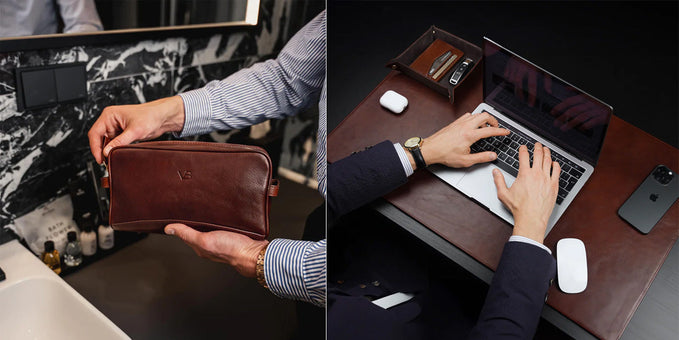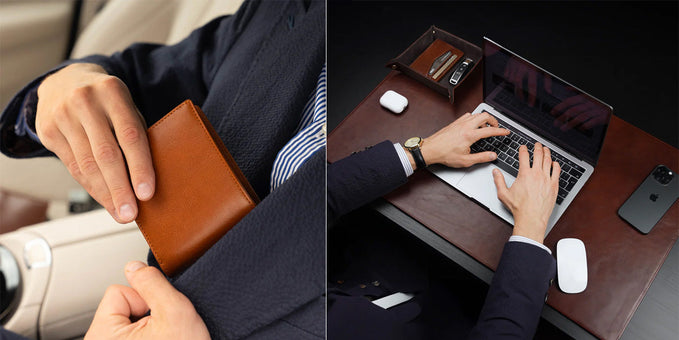Suede vs Leather: Key Differences and Similarities Explained

If you want to understand the difference between suede and leather, as well as the similarities, then our full guide below will help:
Key Difference Between Suede and Leather
Although both leather and suede are made from the skin of animals, they have different qualities.
The exterior layer of the skin is used to make leather, while the inner layer is used to make suede.
This provides suede with a delicate, velvety texture and leather with a smooth, shining surface.
Here is a table comparing the two materials:
|
Feature |
Leather |
Suede |
|
Definition |
A robust, adaptable, and resilient natural material made from animal skin |
Animal skin is used to make suede, which is prized for its velvety smooth texture |
|
Made from |
Outer side of the skin |
Flesh side |
|
Texture |
Buttery, smooth and has a sheen |
Matty and textured |
|
Cost |
More expensive |
Less expensive |
|
Durability |
More durable |
Less durable |
|
Care |
Needs to be moisturized and cleaned regularly |
Needs to be brushed and cleaned regularly |
|
Best uses |
Outerwear, bags, shoes, furniture |
Clothing, shoes, accessories |
Example of a full grain leather bag from Von Baer:
Characteristics of Leather
Leather is a versatile material with various types, each offering unique characteristics and applications.
Some common types of leather include:
- Vegetable-Tanned Leather: Made from organic materials like tree bark, vegetable-tanned leather has a hard, unyielding texture and ages well, gaining in beauty over time. This is the highest quality.
- Aniline Leather: Aniline leather displays the natural texture and grain because it is uncoated and dyed with soluble colours. Although it feels smooth and luxurious, it is more susceptible to stains and fading.
- Semi-aniline leather: It is a kind of leather that resembles aniline leather in some ways. Its thin surface coating keeps the leather's natural feel and appearance while providing protection against fading and stains.
- Polymer: Leather coated by a polymer or pigment coating gives greater resistance to stains and abrasion. It offers improved durability and simpler upkeep.
- Crhome-tanned: Leather that has been chrome-tanned uses chromium salts as the tanning process. With outstanding color fastness and water resistance, this method creates soft, flexible leather.
- Other types of leather include those that have been synthetically tanned, brain-tanned, chamois, rose-tanned, alum-tanned and those that have been made from rawhide. Each of these leathers has distinct properties and manufacturing techniques.
Learn more about vegetable tanned leather in this video:
Numerous products and industries use leather extensively, including the following:
- Furniture: Chairs, ottomans, couches, and other furniture pieces with leather upholstery have a more sophisticated appearance. It combines comfort and toughness.
- Style: To produce long-lasting, as well as trendy things like trousers layers, devices, as well as skirts, the garment industry regularly utilizes natural leather.
- Sports: Leather is used in various sporting goods, such as gloves, balls, and shoes.
- Residence Decor: Leather can be found as rugs, cushions, and also wall surface treatments, to name a few ornamental items, giving you a feeling of coziness and sophistication in indoor areas.
- Vehicles: Due to its superb look and online reputation for standing up to abrasion, natural leather is an excellent option for vehicle interiors.
Pros of Leather:
- Natural leather has a timeless, luxurious look that is visually appealing.
- Comfy in various climate conditions, natural leather is an absorptive product that adapts to body temperature levels.
- All-natural Material: Leather is naturally degradable, and also renewable, making it an environment-friendly selection for diligent customers.
- Toughness: Leather items are renowned for their high degree of resilience.
Disadvantages of Leather:
- Cost: When contrasted to artificial options, natural leather items will cost you more, as a result of the higher price of the raw products, and also the more intricate production methods.
- Routine conditioning, as well as cleansing, are needed for natural leather to preserve its elegance as well as stop it from drying or fracturing in time.
- Although natural leather is frequently solid, if it is not correctly taken care of, it can be at risk of spots, scrapes, and also moisture-related damages.
- Moral Considerations: Some individuals voice moral arguments against using items made from animals, and instead choose cruelty-free options.

Related articles:
- Leather
- Faux leather
- Vegan leather
- Bonded vs Real vs Faux leather
- Bonded leather
- Genuine leather
- Pleather
- Top grain leather
- Leather guide for beginners
- What is leather patina
Characteristics of Suede
Here are the common characteristics of suede:
- Suede is renowned for being soft and luxurious.
- Suede has a napped surface area and also a soft, creamy structure.
- It looks matte and has a deluxe feeling to the touch.
- Flexibility: Suede is incredibly flexible, making it very easy to put on and work with.
- Suede is frequently lighter and thinner than other types of natural leather.
Due to its distinctive structure as well as enticing look, suede has a wide array of applications. Suede is regularly made use of for:
- Suede is popular in fashion, and is often used to make clothes, bags, shoes, and accessories (like bags). It gives a luxurious feel that makes it appealing to those who want to look stylish.
- Suede is regularly used as a lining product for natural leather products like purses and wallets. Its soft and luxurious structure boosts the product's high quality and convenience.
- Suede is used in interior design too, ideal for upholstered furniture, wall treatments (like curtains), and soft furnishings like pillows.

Pros of Suede
- Suede is renowned for its soft as well as flexible feeling that makes using it a comfy and pleasurable experience.
- Breathability: Suede is breathable, making it comfortable to wear in various climates.
- Suede's one-of-a-kind matte shine and structure gives it a classy and innovative look that provides a touch of beauty.
- Suede is versatile as it's straightforward to deal with, and the variety of colors makes it useful in various applications.
Cons of Suede
- Durability: Suede is typically less durable than full-grain leather, making it more susceptible to wear and tear with frequent use. However, using the right handling methods and maintenance can increase its longevity.
- Damage and Stain Resistance: Compared to other types of leather, suede is more susceptible to water damage, fading, and stains.
- Cleaning: To properly remove stains and grime from suede without harming the fabric, you need to use specialist techniques and instruments, including suede brushes. To keep the suede's quality, using the suggested manufacturer's cleaning procedures is critical.
- Water Resistance: Suede is easily damaged by water because it isn't naturally waterproof. Although preventative treatments might increase its water resistance, it's crucial to keep in mind that they are not 100% reliable. Items made of suede should be handled with extra care to keep them dry and away from excessive moisture.
Understanding suede's characteristics and pros and cons can help individuals make informed decisions when choosing suede products or considering alternatives.
Related articles:
- Vegetable tanned leather
- Leather tanning
- What is artificial leather?
- What is full grain leather
- Where does leather come from
- Mushroom leather
- Napa leather
- Pebbled leather
- Leather grades
- How is leather made
- Suede
- PU leather
- Bonded leather vs Faux leather
- Italian leather
- How to tell if leather is real
- Buffalo leather
What is Leather?

Natural leather, which is made from animal skin, is renowned for its sturdiness, adaptability, and durability.
Although cowhide is frequently used to create leather, other animal skins, such as those from reptiles, amphibians, and mammals, can also be used.
Leather producers may occasionally even purchase skins from exotic animals like kangaroos, pythons, camels, and ostriches.
A vast range of leather products, including handbags, shoes, purses, gloves, belts, hats, and watch straps, can be made using this large spectrum of materials.
Processing and tanning the animal skin are steps in the leather-making process. Different bodily sections of the animal produce hides with various characteristics. Not all animal hides, nevertheless, are tanned and turned into leather.
The goal of tanning is to alter the skin's protein structures—especially collagen fibers—to make them more resistant to deterioration. To do this, tanneries use chemical processes, frequently using tannin from oak trees.
The hair on the skin's surface layer is also eliminated during the tanning process, creating a flexible, smooth, and long-lasting substance. This time-tested method is frequently used to make accessories for both men and women.
Leather not only has aesthetic appeal but also has practical advantages. Because it effectively transfers moisture and aids in body temperature regulation, it is comfortable to wear.
Because of this, leather is a well-liked option for many fashion industry uses.
Types of Leather
Depending on its properties and manufacturing method, leather can be classed into a number of different varieties. These other leather varieties are listed below:
- Full Grain: The best type of leather is full grain leather. It is known for having strength and tenacity. At Von Baer, we only use full grain leather in our bags, to ensure you receive the best quality product possible.
- Top Grain: To improve its appearance or correct some flaws, this type of leather has undergone some sort of correction or alteration.
- Split Leather: Since split leather is made by slicing the top grain from the lower layers, it is less resistant to tearing and tearing than full grain or top grain leather. It is typically utilized in split leather or suede items.
In addition, different types of leather can be divided based on how they are made and how they are treated. Several instances include:
- Brain-tanned leather, which is preserved and made softer by utilizing animal brains or other emulsified fats, is primarily produced using Native American traditions.
- Vegetable-tanned leather has a unique appearance and is created from strong, long-lasting materials like tree bark.
- Because natural tannins were not used in the production of synthetically tanned leather, it is more durable and water and stain resistant.
- Leather Chamois: This leather, which is produced from sheep or goat skin, is prized for its suppleness, flexibility, and great absorption properties.
- When leather is chrome tanned, chromium salts are used to cure it, creating supple, soft leather that is also stretch and water resistant.
Gloves and book binding are two common uses for leather that has been tanned with aluminum salts because it is soft and lightweight.
Rawhide, which is typically used to produce dog chews or drumheads, is untanned animal skin that has been cleaned, stretched, and dried.
Only a few different types of leather are available, and each has unique qualities and applications based on how it was made and how it was treated.
Related pages:
What is Suede?
The underside of an animal's skin is used to make this kind of leather. Although lamb skin is frequently used in the production of suede, goat, deer, pig, and cattle skins can also be employed.
Suede is a well-liked material for gloves and women's accessories because of its softness, pliability, and suppleness.
Additionally, it's used to make shoes and for upholstery.
Suede lacks the original protective outer covering of other varieties of leather, leaving it more vulnerable to stains and damage.
Suede is prone to damage and can quickly become dirty if not properly cared for. In order to maintain its longevity and quality, it is crucial to perform the proper maintenance procedures.
Suede is less robust and thinner than other varieties of leather. To make suede, producers separate the skin's underside during the manufacturing process.
Suede is more prone to wear and tear since it has a smooth and velvety texture rather than the other leather types' harsh external surface.
To ensure correct care and maintenance and to extend the enjoyment of suede leather's softness and opulent feel, it is essential to understand the unique qualities and vulnerabilities of the material.
Types of Suede
Based on the animal skin used, several suede varieties can be grouped. Here are a few illustrations:
- Cowhide suede: It is distinguished from other types of suede by its rough texture. It provides a rougher, more textured appearance.
- Sheepskin Suede: This kind of suede is regarded as being the softest. It frequently comes from lamb and sheep skin, giving it a plush, velvety feel.
- Pigskin Suede: When compared to other forms of suede, pigskin suede is heavier, thicker, and more resilient. It provides a strong and reliable alternative for suede goods.
These variances in suede kinds enable various aesthetics and functionalities, accommodating a range of preferences and uses.
FAQs
Which is stronger leather or suede?
Suede is not as durable as leather. Suede is removed from the inner side of the hide, producing a more elastic and softer material, while leather is produced from the outside grain side of the skin, which is stronger and more durable.
Is it easier to clean Suede than leather?
In comparison to leather, suede is frequently thought to be easier to maintain.
While suede may be cleaned with a suede brush or suede eraser to remove dirt and stains, leather needs particular cleaning procedures and chemicals to maintain its beauty. It's crucial to remember that suede may eventually fade if it is repeatedly cleaned.
Is suede considered authentic leather?
Yes, suede is a genuine leather variety. Animal hide is used to create both leather and suede. Leather is taken from the outside of the hide, whereas suede is manufactured exclusively from the inside.
Is suede waterproof?
Suede is not water resistant, and also is a lot more at risk to harm from water contrasted to natural leather.
Suede can conveniently take in water, which can create spots, and also impact its look. Natural leather on the other hand has all-natural water resistance, and also can stand up to water to a higher degree.
Nonetheless it's vital to keep in mind that neither suede neither natural leather is entirely water-proof, and also both need to be shielded, and also treated with proper items to improve their water resistance.
Conclusion
We hope you enjoyed our article on suede vs leather.
If you have any questions or comments, contact us at info@vonbaer.com, or leave them in the comments.
Want to read more? Check out our Leather pages.

Author: Albert Varkki
Albert Varkki is the co-founder of Von Baer. He understands leather products as a consumer, supplier, and a manufacturer, helping you with the inside knowledge you need, to choose the perfect leather product for you.
We strive for the highest editorial standards, and to only publish accurate information on our website.
Leave a Comment
Your email address will not be published.







